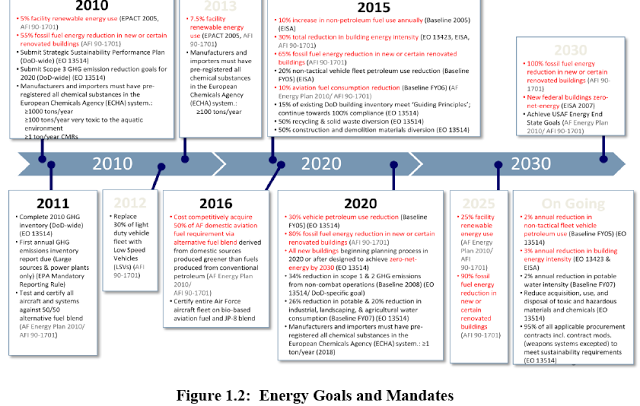In the air domain, for example, advanced engines, fuels, structures, and operations were identified that promise to achieve single and double digit improvements in efficiencies promising increases in loiter/ranges and/or enhanced missions. In the space domain, highly efficient photovoltaics, Hall and electric thrusters, and new battery technologies promise more efficient and resilient space operations and revolutionary new services such as in-space power beaming and on-orbit refueling. In the cyber domain, efficient algorithms and processors and cloud computing promise not only energy savings but also enhanced cyber resiliency. Finally, in infrastructure, advances in renewables, smart grids, and Solar-to-Petrol plants promise to increase energy resilience and independence for both fixed and expeditionary bases.
Across all Air Force domains of operation, Energy Horizons identifies game changing technologies in energy generation, storage and use. Advances in energy generation include ultra-efficient, flexible photovoltaics; small, auto-safing modular nuclear reactors; and efficient and abundant non-food source biofuels. Advances in energy storage (advanced batteries, ultra-capacitors, high power fly wheels, and superconducting magnetic energy storage) promise significant improvements in power and energy density and with increased flexibility in charge/discharge cycles. Finally, nanomaterials (e.g., carbon-carbon nanotubes, memristers), cloud computing, efficient supercomputing, and energy micromonitoring promise multiplicative efficiencies from energy efficient structures and microelectronics, efficient and resilient computing architectures, energy optimized platform designs, and enhanced energy situational awareness and management.
Aerodynamics
Propulsion for Airplanes
In the near-term, incorporating current technologies into legacy transport fleet engines could lead to a 1-6% improvement in fuel burn. Full scale engine replacement, while more expensive, offers as much as a 15-25% improvement in fuel burn for fighter, bomber, attack, and transport aircraft. For smaller aircraft, initiatives like the Efficient Small Scale Propulsion (ESSP) look to provide an approximately 25% reduction in SFC, in this case for remotely piloted aircraft (RPAs). Other technologies such as fuel cells, could improve the efficiency and range for RPAs
Materials and Energy Harvesting
Space Energy
If you liked this article, please give it a quick review on ycombinator or StumbleUpon. Thanks

Brian Wang is a Futurist Thought Leader and a popular Science blogger with 1 million readers per month. His blog Nextbigfuture.com is ranked #1 Science News Blog. It covers many disruptive technology and trends including Space, Robotics, Artificial Intelligence, Medicine, Anti-aging Biotechnology, and Nanotechnology.
Known for identifying cutting edge technologies, he is currently a Co-Founder of a startup and fundraiser for high potential early-stage companies. He is the Head of Research for Allocations for deep technology investments and an Angel Investor at Space Angels.
A frequent speaker at corporations, he has been a TEDx speaker, a Singularity University speaker and guest at numerous interviews for radio and podcasts. He is open to public speaking and advising engagements.











